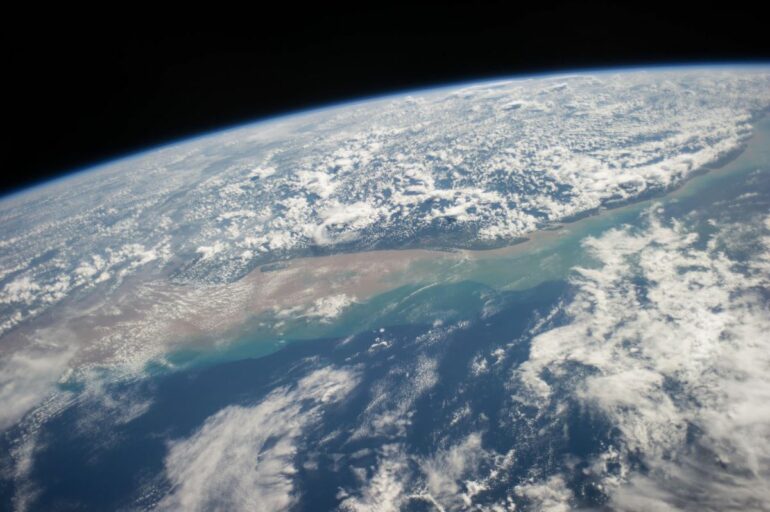Oxygen is critical for life, but what promoted the first rise in atmospheric oxygen on Earth and precisely when it happened have been challenging scientists for the last 70 years.
Most scientific research suggests oxygen rose rapidly about 2.4 billion years ago and then fell just as abruptly over the next 200 million years. This event is called the Great Oxygenation Event (GOE).
A new international study led by a team of geologists from the University of Tasmania, in collaboration with scientists from the Carnegie Institute in Washington and the University of Toronto, offers an alternative theory.
The researchers propose that the rise of atmospheric oxygen was a very slow process between 2.8 and 1.8 million years ago related to the collision of continental plates during supercontinent cycles and the evolution of cyanobacteria in our oceans.
Atmospheric oxygen rose over a period of a billion years, with a peak close to present-day levels of 21% oxygen around 1.9 billion years ago. Oxygen then declined for a further period, known as the boring billion.
The research demonstrated that the evolution of minerals in the Earth’s crust correlates with the rise of oxygen due to the presence of new oxidized metal species that only became available because of the rise in oxygen.
The new theory uses measurements on the redox chemistry of minerals that form in rocks and on the sea floor through geological time.
University of Tasmania geologist Professor Ross Large said the results are based on a wealth of data from a range of minerals and isotopes.
The teams at the University of Tasmania, Toronto and Carnegie institute have built massive databases on the chemistry of a wide range of minerals, involving tens of thousands of analyses collected over the last 15 years.
“The worldwide trend toward data-driven research is increasing because our technology is rapidly changing, enabling thousands of analyses to be acquired,” Professor Large explained.
“Much previous research on this topic has depended on limited analyses, supported by computer models to fill in the data and attempt to predict outcomes. This has commonly led to ‘straight line’ interpretations that have ignored the Earth’s up-and-down cycles through geological time.”
Professor Large says the first rise in oxygen was accompanied by a decline in carbon dioxide and methane, producing ocean and atmosphere conditions more amenable to life.
“The old Archean oceans prior to 2.6 billion years ago were enriched in toxic elements such as arsenic and mercury, and very inhospitable to life as we know it,” Professor Large said.
“Our research shows that with increasing oxygen, the chemistry of the ocean changed, toxic elements declined and elements important to life such as phosphorus, molybdenum and zinc became more available to stimulate evolutionary change.”
Professor Large said these major changes were brought on by the first development of continental drift related to the supercontinent cycles, which describe the assembly, duration and fragmentation of the largest land masses on Earth.
“Mountain building during collision of plates in the first phase of each supercontinent cycle led to erosion of nutrients to the oceans, stimulating life and release of oxygen to the atmosphere,” Professor Large explained.
“We propose that two phases of mountain building helped drive the rise in oxygen, production of new minerals and evolution of early life. The first occurred around 2.8 billion years ago with the formation of the supercontinent Kenorland, and the second around 2.1 billion years ago, which formed the supercontinent Nuna.”
The third oxygen cycle started about a billion years ago, and from then on the cycles increased in frequency from about 200 million years apart down to 60 million years apart. Previous research by the team has shown that each oxygen cycle ended with a mass extinction but was rapidly followed by an explosion in evolution.
Contrary to some suggestions, Professor Large does not consider we are heading into another mass extinction. He said that past mass extinctions involved carbon dioxide rising to greater than 4000 parts per million (ppm), compared to about 300 ppm today, and oxygen dropping well below 10% and possibly as low as 5%, compared with 21% today.
He suggests that based on Earth cycles, the next mass extinction is about 30 million years away.
More information:
Ross R. Large et al, Evidence that the GOE was a prolonged event with a peak around 1900 Ma, Geosystems and Geoenvironment (2022). DOI: 10.1016/j.geogeo.2022.100036
Provided by
University of Tasmania
Citation:
Ancient oxygen levels provide clues to the timing of life and death on Earth (2022, February 28)



